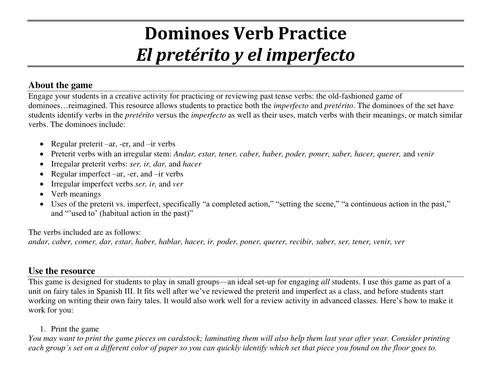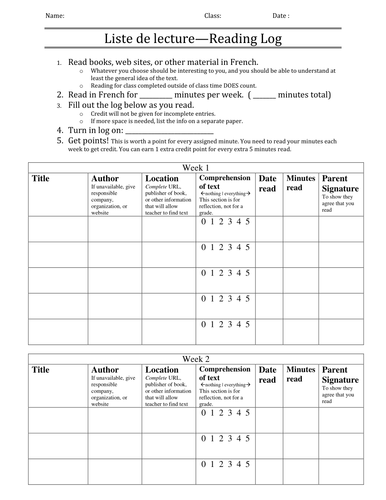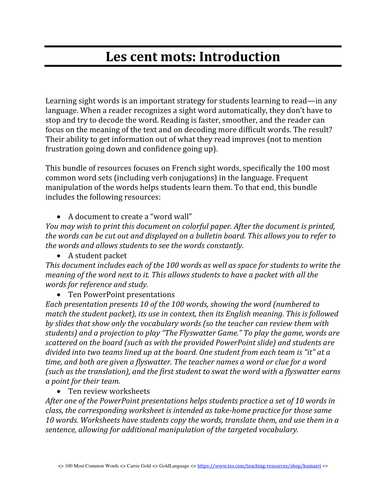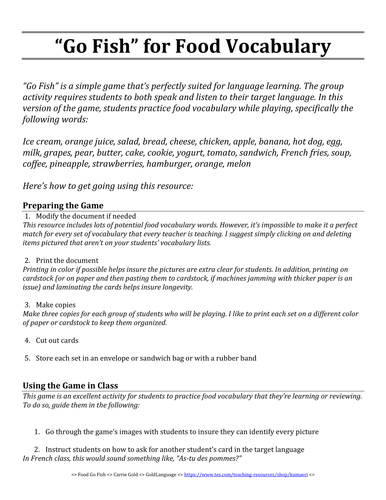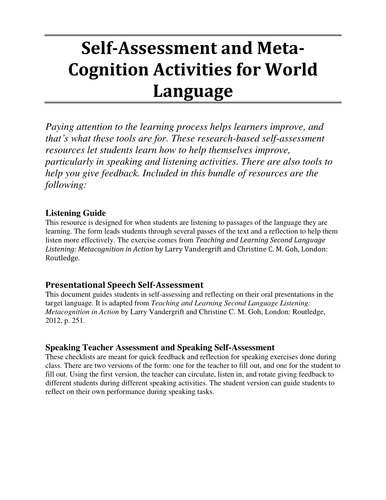53Uploads
16k+Views
13k+Downloads
All resources

Dot-to-Dot: Spanish numbers and speaking for beginning learners
This fun dot-to-dot activity allows students to creating an original design, then gets them speaking exclusively in Spanish using numbers (1-64) to guide their partner in replicating the drawing. This is a great activity to get even early beginners speaking, listening, and understanding Spanish—and a great way to start building confidence in using the language.
Download includes printable worksheet as well as detailed instructions.

Dot-to-Dot: French numbers and speaking for beginning learners
This fun dot-to-dot activity allows students to creating an original design, then gets them speaking exclusively in French using numbers (1-64) to guide their partner in replicating the drawing. This is a great activity to get even early beginners speaking, listening, and understanding French—and a great way to start building confidence in using the language.
Download includes printable worksheet as well as detailed instructions.

Téléfrançais Worksheets: Beginning French Listening For Free Video Series on YouTube ~ Includes Key
Looking for a way to engage beginning students in French in the language? I spent several years looking for a show that was entirely in French, but that was suitable for beginners. I found that in Téléfrançais.
Téléfrançais is a Canadian TV show designed for kids learning French. The 30 ten-minute episodes are available for free on YouTube. These worksheets help students more easily follow along, better comprehend the language of the all-French show, retain more of what they hear, and stay more focused.
WHAT’S INCLUDED
–A single, black-and-white PDF file
–A half-page worksheet for each of the 30 Téléfrançais episodes (printed two per page)
–An answer key that appears directly after each worksheet
THE CONTENT
–Each worksheet includes around 12 questions
–Question types are primarily multiple choice, matching, and short-answer questions with 1-2 word answers
–Questions and answers are mix of French and English
MORE ABOUT TELEFRANÇAIS
The French-Canadian TV show has thirty 10-minute episodes available for free on YouTube. The show is dated, but it’s one of my favorite resources for teaching French. I show it to my junior high and high school French I students starting in about the second quarter. As the school year goes on, they inevitably start singing along with the theme song. They always groan when they first see Pilote. They talk about how they miss Sophie when she leaves the show. Like I said, it’s dated, but it engages students and really does help them learn French. And it’s free!
I made this set of worksheets to help students follow along with the show. With these worksheets, students are able to better follow the action and language. I have used them for years, and they have been a hit with other teachers as well!
TERMS AND CONDITIONS
This product is copyrighted to Carrie E. Gold/Blue and Gold Language. It is to be used and reproduced for your own purposes and for use with your own students only. They should not be shared (in digital or print form) for the use of others outside yourself and your own current students (for example, it cannot be shared with other teachers). The products may be repurposed for your own use or use by your own students only, with the condition that the products are not used commercially, and that they are still attributed to Carrie E. Gold/Blue and Gold Language.

Battleship: Spanish alphabet, numbers, and speaking for beginning learners
Authentic language? Check. Gets students speaking? Check. An element of fun? That, too. This resource engages students in the naval battle game similar to Battleship, allowing even beginners to communicate exclusively in Spanish. Players use numbers and letters to play–perfect to get beginning students speaking, listening, and understanding Spanish. Students play in pairs, which means everyone uses the language. This is a great info-gap activity to get beginning students speaking confidently.
I use this resource in the first weeks of junior high and high school Spanish I, as soon as we’ve covered the alphabet and numbers. I love getting students speaking right from the beginning.
Download includes printable game board as well as detailed instructions.

Dominoes Verb Practice: El pretérito y el imperfecto
Engage your students in a creative activity for practicing or reviewing past tense verbs: the old-fashioned game of dominoes…reimagined. This resource allows students to practice both the imperfecto and pretérito. The dominoes of the set have students identify verbs in the pretérito versus the imperfecto as well as their uses, match verbs with their meanings, or match similar verbs. The dominoes include:
• Regular preterit: –ar, -er, and –ir verbs
• Preterit verbs with an irregular stem: Andar, estar, tener, caber, haber, poder, poner, saber, hacer, querer, and venir
• Irregular preterit verbs: ser, ir, dar, and hacer
• Regular imperfect: –ar, -er, and –ir verbs
• Irregular imperfect verbs: ser, ir, and ver
• Verb meanings
• Uses of the preterit vs. imperfect, specifically “a completed action,” “setting the scene,” “a continuous action in the past,” and “used to (habitual action in the past)”
The verbs included are as follows:
andar, caber, comer, dar, estar, haber, hablar, hacer, ir, poder, poner, querer, recibir, saber, ser, tener, venir, ver

French Drawing Worksheet: Describing People Vocabulary ~ Beginning French ~ Reading Practice
Looking for a fun way to practice reading and describing vocabulary for your beginning French students? With this worksheet, students read an all-French description of a person, then draw and color in the face to match the text. I love this kind of activity. It allows students to use a different modality to learn–not to mention adding some fun variety to homework time. It also uses French in context.
This worksheet is excellent to use when students are learning to describe people, but it’s also a great review activity, as well as fantastic for a sub plan, emergency lesson plan, or to fill in extra time–while not being busy work.
Who is this for?
This activity works well in beginning middle and high school French classes who have learnedêtre, avoir, and some describing vocabulary. Students should be comfortable with reading.
What material does it cover?
This worksheet utilizes the following vocabulary: avoir, être, yeux/oeil, cheveux, vert, noir, bleu, gris, rose, noisette, marron, rousse, long, court, raide, frisé, bouclé, chauve, moustache, barbe, petit, grand, nez, oreille, bouche
What’s needed for this activity?
Students will need colored pencils or similar.
What’s included?
This product consists of a single-page PDF of the worksheet.
Your Satisfaction
I want you to be happy with your purchase. If you have any questions, problems, or feedback, please email ContactTheBlueAndTheGold@gmail.com.
Terms and Conditions
Products from Carrie E. Gold / BlueAndGoldLanguage are copyrighted to Carrie E. Gold. They are to be used and reproduced for your own purposes and for use with your own students only. They should not be shared (in digital or print form) for the use of others outside yourself and your own students, including with other teachers. The products may be repurposed for your own use or use by your own students only, with the condition that the products are not used commercially, and that they are still attributed to Carrie E. Gold and BlueAndGoldLanguage.
If a refund is granted, you agree that, as the product is a digital download, you will immediately delete the product, that you will not at any time copy or repurpose any portion of the product, that you will no longer use any portion of the product, and that you will not share any portion of the product in any way with others.

Battleship: Practicing shopping exchanges and vocabulary
The game of Battleship is an excellent activity for the foreign language classroom. Not only does it engage students, this activity also scaffolds students’ use of whole language: It has them speak to communicate a message and listen to understand what others are saying. This version of Battleship has students practice the names of different products they might shop for and their prices. By doing so, students role-play a possible shopping conversation several times. This provides excellent practice for using shopping vocabulary and prices, practicing shopping conversation, and asking and answering questions.
Note: The items students “shop” for in this activity are: un livre, une cravate, une écharpe, une lampe, un sandwich, une salade, un t-shirt.
Students work in pairs to play the game. As indicated in the directions, each player first places “ships” by marking the squares of their choosing on the “vous” grid. Students then work to discover the other player’s ships. The first one to do so wins the game.
To look for a ship, the student follows the scaffolded sentences shown on the activity: To ask if a ship is in a square of the grid, the student asks if their partner would like a product (along the side of the grid) of a certain price (along the top of the grid). The square in question is where these two pieces of information line up. After the second player hears the first player’s question, the second player answers that yes, they would like the product (indicating they have a ship or part of a ship in that square) or no, they would not (indicating the space is empty). Students take turns asking about different squares on the grid in order to find all of their partner’s ships.
It is my hope that students enjoy this activity, that using it they improve their speaking and listening skills, and that this resource eases some of the difficulty of planning engaging, effective lessons.

Monthly Reading Log: Improve target language reading through frequency
Research has shown that one of the best ways for students to improve their reading proficiency is simply by reading. What they read, however, matters. The best material for students to improve their reading proficiency is material they choose themselves, as that's what they are most interested in and motivated to read.
This reading goal was designed with that research in mind. Teachers of any target language can give this assignment, since it can be customized to the target language as well as student needs. Teachers simply need to change the title of the assignment and the name of the target language on lines 1 and 2. After that, there is space where the number of minutes assigned and assignment due date can be filled in by students when the assignment is given.
The reading log is designed to span four weeks. It asks students to document information about the material read as well as self-assessing comprehension. The assignment also asks for a parent signature.
I suggest students start this kind of target-language independent reading at an intermediate level of language study. I first assign it to French III students midway through the year as well as assigning it to advanced classes.
It is my goal that this simple tool will help students improve their reading proficiency as well as the enjoyment they gain from reading in their target language.

French Sight Word Practice: Improve reading by practicing the 100 most common French words
Learning sight words is an important strategy for students learning to read—in any language. When a reader recognizes a sight word automatically, they don’t have to stop and try to decode the word. Reading is faster, smoother, and the reader can focus on the meaning of the text and on decoding more difficult words. The result? Their ability to get information out of what they read improves (not to mention frustration going down and confidence going up).
This bundle of resources focuses on French sight words, specifically the 100 most common word sets (including verb conjugations) in the language. Frequent manipulation of the words helps students learn them. To that end, this bundle includes the following resources:
• An introductory document
• A document to create a “word wall”
• A student packet
This document includes each of the 100 words as well as space for students to write the meaning of the word next to it. This allows students to have a packet with all the words for reference and study.
• Ten PowerPoint presentations
Each presentation presents 10 of the 100 words, showing the word (numbered to match the student packet), its use in context, then its English meaning. This is followed by slides that show only the vocabulary words (so the teacher can review them with students) and a projection to play “The Flyswatter Game.”
• Ten review worksheets
After one of the PowerPoint presentations helps students practice a set of 10 words in class, the corresponding worksheet is intended as take-home practice for those same 10 words.
As students manipulate these words, you will see improvement in their reading ability as well as in their confidence as they approach the written word.

"Go Fish" for Food Vocabulary
“Go Fish” is a simple game that’s perfectly suited for language learning. The group activity requires students to both speak and listen to their target language. In this version of the game, students practice food vocabulary while playing, specifically the following words:
Ice cream, orange juice, salad, bread, cheese, chicken, apple, banana, hot dog, egg, milk, grapes, pear, butter, cake, cookie, yogurt, tomato, sandwich, French fries, soup, coffee, pineapple, strawberries, hamburger, orange, melon

Self-Assessment and Meta-Cognition Activities for World Language
Paying attention to the learning process helps learners improve, and that’s what these tools are for. These research-based self-assessment resources let students learn how to help themselves improve, particularly in speaking and listening activities. There are also tools to help you give feedback. Included in this bundle of resources are the following:
• Listening Guide
• Presentational Speech Self-Assessment
• Speaking Activity Teacher Assessment
• Speaking Activity Self-Assessment
• Emotional Temperature Chart
• Speaking Focus Signs

French Past Tense Practice: Dominoes Game for Imparfait and Passé Composé ~ Imperfect, Past Perfect
Help your French world language students practice the imparfait and passé composé with a game! Use this printable to make a dominoes game designed to play in groups of 3-5 students.
Who is this for?
This activity works well in middle and high school French classes that are learning imparfait and passé composé. Students should be comfortable with reading.
What is it?
Instead of dots, the sides of each dominoes has things like an infinitive, a helping verb (avoir or être), a verb correctly conjugated in the imparfait or passé composé, or a description of when to use the imparfait versus the passé composé. Students can match up their dominoes by making matches such as a verb to its meaning, or a verb to its helping verb, or a verb conjugated in the imperfect to a situation where you’d use the imperfect (not passé composé). Don’t worry: The resource includes instructions and examples.
What material does it cover?
• -er, -ir, and -re verbs
• “House To Be” or “Dr. and Mrs. Vandertramp” verbs (verbs that use the helping verb “être” and agreement in the passé composé”)
• Verb meanings
• Conjugations in the passé composé and imparfait
• Uses of the passé composé vs. the imparfait, specifically “setting the scene,” “a completed action,” “a continuous action in the past,” and “’used to’ (habitual action in the past)”
Which verbs?
This activity includes the verbs aller, avoir, boire, écrire, être, faire, finir, lire, manger, mettre, naître, parler, pouvoir, and voir.
What’s included?
This product consists of a 12-page PDF with instructions, examples, and tips, as well as the 60 unique dominoes–enough for one set (you’ll print a set for each group of students).
Your Satisfaction
I want you to be happy with your purchase. If you have any questions, problems, or feedback, please email ContactTheBlueAndTheGold@gmail.com.
Terms and Conditions
Products from Carrie E. Gold / BlueAndGoldLanguage are copyrighted to Carrie E. Gold. They are to be used and reproduced for your own purposes and for use with your own students only. They should not be shared (in digital or print form) for the use of others outside yourself and your own students, including with other teachers. The products may be repurposed for your own use or use by your own students only, with the condition that the products are not used commercially, and that they are still attributed to Carrie E. Gold and BlueAndGoldLanguage.
If a refund is granted, you agree that, as the product is a digital download, you will immediately delete the product, that you will not at any time copy or repurpose any portion of the product, that you will no longer use any portion of the product, and that you will not share any portion of the product in any way with others.

Battleship: French alphabet, numbers, and speaking for beginners
Authentic language? Check. Gets students speaking? Check. An element of fun? That, too. This resource engages students in the naval battle game similar to Battleship, allowing even beginners to communicate exclusively in French. Players use numbers and letters to play–perfect to get beginning students speaking, listening, and understanding French. Students play in pairs, which means everyone uses the language. This is a great info-gap activity to get beginning students speaking confidently.
I use this resource in the first weeks of junior high and high school French I, as soon as we’ve covered the alphabet and numbers. I love getting students speaking right from the beginning.
Download includes printable game board as well as detailed instructions.





